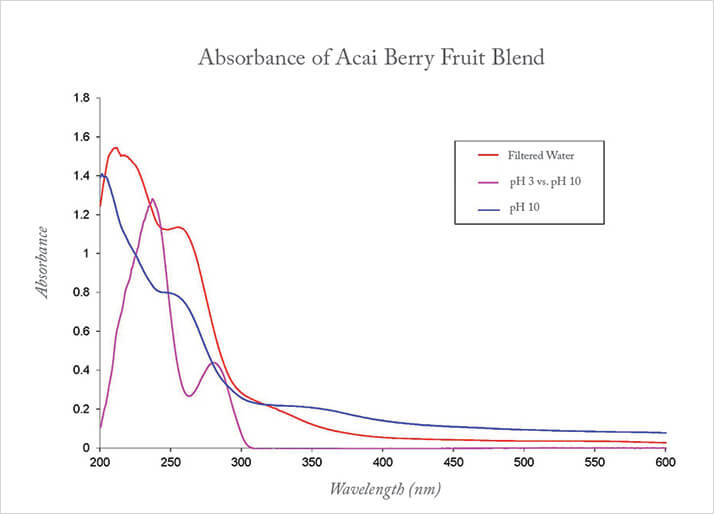Summary
The acai berry has been reported to have the highest levels of antioxidant anthocyanins, measured as oxygen radical absorption capacity (ORAC), of any fruit or vegetable. Anthocyanins are natural pigments that not only give the acai berry its unique color, but also its remarkable anti-oxidant powers. In this application note, we measured the absorbance of a nutrient-dense juice blend comprising acai berries and other fruits.

Introduction
Absorbance measurements are a simple and non-destructive way to measure concentration. The amount of absorbance is proportional to the concentration of the sample. Often, components of a mixture, such as a fruit juice blend containing acai berries, can be identified as individual peaks. In the case of the acai berry, the main color pigment has a strong absorption band at 530 nm.Component-based spectrometer systems are ideal for absorbance measurements. A good general-purpose spectrometer option such as the Ocean Optics USB2000+ or USB4000 spectrometers can be optimized for the wavelengths of interest and configured with optical bench accessories, such as optical slits and order-sorting filters. Indeed, if your absorbance application requires very high resolution to resolve closely aligned peaks, or significant light throughput is required to measure solutions, the grating and entrance aperture can be optimized to the samples being measured.
Measurement Conditions
Dilutions of a nutrient-dense fruit juice blend (composed more than 50% by weight of acai berries) were prepared in water, in a pH 3 buffer and in a pH 10 buffer. We used a USB4000-UV-VIS (200-850 nm) spectrometer to measure absorbance of the solutions in a 1 cm quartz cuvette in a cuvette holder, with a deuterium source for illumination and premium-grade, solarization-resistant patch cords both to carry light to the sample chamber and from the sample to the spectrometer. Solarization-resistant fibers are recommended for UV applications, where radiation <300 nm can degrade transmission in silica fibers. Although not part of our experiment setup, a NIST-traceable photometric absorbance standard is useful for quantitative, traceable absorbance measurements.
Results
Anthocyanins – the natural pigments giving the juice blend its dark color – absorb at 530 nm. These anthocyanins change color with pH. The spectra of the juice samples in all solvents showed a strong peak at 260 nm, most likely the result of high concentrations of amino acids. In pH 10 buffer, a secondary peak appears in the 350 nm region. The absorbance difference spectra of the juice blend in the pH 3 buffer versus the pH 10 buffer shows clearly a species with an absorbance peak at 280 nm (Figure 1).
 Figure 1: Absorbance spectra of the acai berry fruit juice blend diluted in water and different pH buffers show the likely effects of amino acids in the buffers.
Figure 1: Absorbance spectra of the acai berry fruit juice blend diluted in water and different pH buffers show the likely effects of amino acids in the buffers.In the case of fruits and vegetables, color is a good thing! The pigments that color our fruits and vegetables reduce damage from free radicals and may lessen damage from inflammatory processes, reduce the risk of cancers and improve the efficacy of our immune systems.





